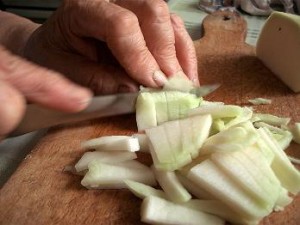The kitchen is the most popular classroom in our house.  Far more interesting than sitting and working from textbooks, it offers the chance for fun hands-on learning. Every recipe is a cross-curriculum adventure.
Far more interesting than sitting and working from textbooks, it offers the chance for fun hands-on learning. Every recipe is a cross-curriculum adventure.
Take, for example, our recent preparation of chicken in paprika sauce. In one recipe, we covered a day’s schoolwork.
There’s the obvious, of course. You need to know how to read to follow a recipe. There’s more, however. One meal can be part of your entire curriculum.
1. Health
The first rule of helping in the kitchen is “wash your hands.” Something as basic as that can lead to a longer discussion on germs, disease, and food safety. It’s amazing how much kids pick up without realizing. When Breanna asks, “How long do you cook a chicken?”, it surprises me to hear my 14-year-old pipe up with the information that time isn’t the key, but internal temperature is.
Health also covers nutrition information. What makes a balanced meal? Is this recipe a healthy choice? I’ll be the first to admit, the chicken in paprika sauce isn’t the healthiest — it certainly is better with normal sour cream than with fat free. We’ll discuss this and see where we can make other choices to help balance that out. How about a salad to go with the dish?
2. Math
Ingredients need to be measured, often in quarters and thirds of units. The lesson can be taken further, though — how much do you need if you do a double recipe? If you want three cups of sour cream, how many pint containers need to come out of the refrigerator?
Allow children to do the measuring, and figure out the math. It may take longer, and it may result in slightly “off” recipes (as one child learned after using a tablespoon instead of a teaspoon to measure red pepper flakes).
3. Science
What is cooking but an edible science experiment? Even the most reliable recipe sometimes offers surprises — today the bread didn’t rise as much, or the squash seems saltier than usual. And somehow, mixing several ingredients that taste awful on their own makes a delicious cake. How did that happen?
Two books that should be on every impromptu culinary school reading list, especially if there are curious children in the house: “Understanding Baking” by Joseph Amendola, and “On Food and Cooking” by Harold McGee. Both offer useful and fascinating explanations of the chemistry and physics of food preparation.
4. Social Studies
Do you know where your spices are traditionally grown? Do you know how they were introduced into other parts of the world? Where did this recipe originate? How did it become something that our family cooks?
These and many other questions can be asked and answered while cooking. Some research may be involved, and the answers may be surprising. You may also go on a surprising journey — who knew that chicken in paprika would lead to discussion of the 1956 revolution in Hungary and from there to the Cold War?
Once The Food Is Ready…
Sitting down and enjoying the meal is just as important as the preparation. It’s a chance to look at the meal and decide if it was successful. What could we change? Should we use more salt next time? Less paprika?
You don’t need a culinary degree from one of the top culinary schools to know the most important lesson: negotiating your way out of doing the dishes.
Noel-Marie Taylor is a dedicated homeschooling mom who loves to talk food, blogging and parenting. You can find more of her homeschooling posts at the online schooling blog for OnlineSchools.com where she frequently provides content relating to a wide variety of homeschooling topics.
 Posts
Posts